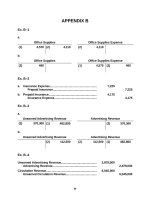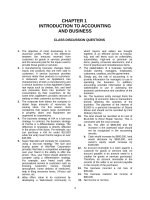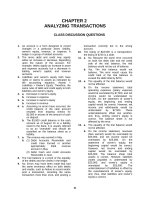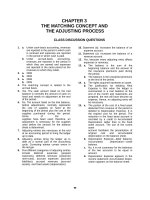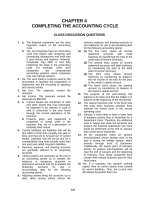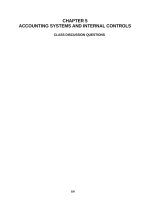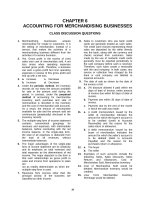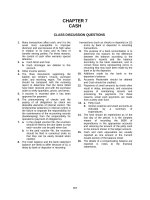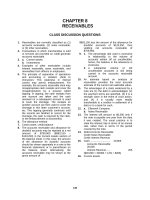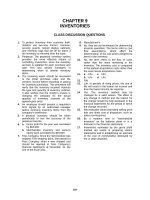Solution manual accounting 21e by warreni ch 22
Bạn đang xem bản rút gọn của tài liệu. Xem và tải ngay bản đầy đủ của tài liệu tại đây (239.29 KB, 49 trang )
CHAPTER 22
PERFORMANCE EVALUATION USING VARIANCES
FROM STANDARD COSTS
CLASS DISCUSSION QUESTIONS
1. Standard costs assist management in
controlling costs and in motivating
employees to focus on costs.
2. Management can use standards to assist in
achieving
control
over
costs
by
investigating significant deviations of
performance (variances) from standards
and taking corrective action.
3. Reporting by the “principle of exceptions” is
the reporting of only variances (or
“exceptions”) between standard and actual
costs to the individual responsible for cost
control.
4. There is no set time period for the revision
of standards. They should be revised when
prices, product design, labor rates, and
manufacturing methods change to such an
extent that current standards no longer
represent
a
useful
measure
of
performance.
5. Standard costs for direct materials, direct
labor, and factory overhead per unit of
product are used in budgetary performance
evaluation. Product standard costs are
multiplied by the planned production
volumes. Budget control is achieved by
comparing actual results with the standard
costs at actual volumes.
6. a. The two variances in direct materials
cost are:
(1) Price
(2) Quantity or usage
b. The price variance is the result of a
difference between the actual price and
the standard price. It may be caused by
such factors as a change in market
prices
or
inefficient
purchasing
procedures. The quantity or usage
variance results from using more or less
materials than the standard quantity. It
can be caused by such factors as
excessive spoilage, carelessness in the
production processes, and the use of
inferior materials.
7. The offsetting variances might have been
caused by the purchase of low-priced,
inferior materials. The low price of the
materials would generate a favorable
materials price variance, while the inferior
quality of the materials would cause
abnormal spoilage and waste, thus
generating an unfavorable materials
quantity variance.
8. a. The two variances in direct labor costs
are:
(1) Rate (price or wage)
(2) Time (usage or efficiency)
b. The direct labor cost variance is usually
under the control of the production
supervisor.
9. No. Even though the assembly workers are
covered by union contracts, direct labor cost
variances still might result. For example,
direct labor rate variances could be caused
by scheduling overtime to meet production
demands or by assigning higher-paid
workers to jobs normally performed by lowerpaid workers. Likewise, direct labor time
variances could result during the training of
new workers.
10. a. The
variable
factory
overhead
controllable variance results from
incurring a total amount of variable
factory overhead cost greater or less
than the amount budgeted for the level
of operations achieved. The fixed
factory overhead volume variance
results from operating at a level above
or below 100% of normal capacity.
b. The factory overhead cost variance
report presents the standard factory
overhead cost variance data, that is,
the volume and the controllable
variances.
11. The budgeted fixed costs at normal volume
are the amount of fixed costs expected to
be incurred for a volume of activity that has
been the historical norm. Actual volume
that exceeds or is less than the historical
norm gives rise to a volume variance.
213
12.
Net unfavorable
variance
direct
materials
price
staffing patterns around various times of
the day (e.g., increasing staff during the
lunch hour).
15. Nonfinancial
performance
measures
provide managers additional measures
beyond the dollar impact of decisions.
Nonfinancial considerations may help the
organization include external customer
perspectives about quality and service in
performance measurements.
13. Net favorable direct materials quantity
variance
14. Standards can be very appropriate in
repetitive service operations. Fast food
restaurants can use standards for
evaluating the productivity of the counter
and food preparation employees. In
addition, standards could be used to plan
214
215
EXERCISES
Ex. 22–1
Ingredient
Cocoa
Sugar
Milk
Total cost
Quantity
×
Price
Total
455 pounds
175 pounds
100 gallons
×
×
×
$0.20 per pound
$0.40 per pound
$1.19 per gallon
$ 91.00
70.00
119.00
$ 280.00
Standard direct materials cost per bar of chocolate:
$280 per batch
= $0.28 per bar
1,000 bars
Ex. 22–2
Direct labor...................................................... $15.00 × 3.5 hours
Direct materials............................................... $7.50 × 20 board ft.
Variable factory overhead............................... $2.20 × 3.5 hours
Fixed factory overhead................................... $0.80 × 3.5 hours
Total cost per unit......................................
216
$ 52.50
150.00
7.70
2.80
$213.00
Ex. 22–3
a.
SAMS BOTTLE COMPANY
Manufacturing Cost Budget
For the Month Ended July 31, 2006
Standard Cost at
Planned Volume
(600,000 Bottles)
Manufacturing costs:
Direct labor.................................................................................
Direct materials..........................................................................
Factory overhead.......................................................................
Total.......................................................................................
$ 7,560
30,240
2,100
$ 39,900
$1.26 × (600,000 ÷ 100) = $7,560
$5.04 × (600,000 ÷ 100) = $30,240
$0.35 × (600,000 ÷ 100) = $2,100
Note: The cost standards are expressed as “per 100 bottles.”
b.
SAMS BOTTLE COMPANY
Manufacturing Costs—Budget Performance Report
For the Month Ended July 31, 2006
Actual Costs
Manufacturing costs:
Direct labor................................
Direct materials.........................
Factory overhead......................
Total manufacturing cost....
$ 8,000
32,600
2,500
$43,100
Standard Cost at
Actual Volume
(640,000 bottles)
$ 8,064
32,256
2,240
$42,560
Cost Variance—
(Favorable)
Unfavorable
$ (64)
344
260
$ 540
$1.26 × (640,000 ÷ 100) = $8,064
$5.04 × (640,000 ÷ 100) = $32,256
$0.35 × (640,000 ÷ 100) = $2,240
c. SBC’s actual costs were $540 more than budgeted. An unfavorable direct
materials cost variance and factory overhead cost variance more than offset a
smaller favorable direct labor cost variance. The unfavorable variances
should be investigated further to discover the cause. Note: The budget
prepared in (a) at the beginning of the month should not be used in the
budget performance report because actual volumes were greater than
planned (640,000 vs. 600,000).
217
Ex. 22–4
a.
Price variance:
Actual price......................................
Standard price.................................
Variance—favorable...................
Quantity variance:
Actual quantity................................
Standard quantity............................
Variance—unfavorable...............
$ 1.85 per pound
2.00 per pound
$(0.15) per pound
× actual quantity, 128,500
$(19,275)
128,500 pounds
126,750 pounds
1,750 pounds
× standard price, $2.00
Total direct materials cost variance—favorable......................................
(15,775)
3,500
$
b. The direct materials price variance should normally be reported to the
Purchasing Department, which may or may not be able to control this
variance. If materials of the same quality were purchased from another
supplier at a price lower than the standard price, the variance was
controllable. On the other hand, if the variance resulted from a marketwide
price decrease, the variance was not subject to control.
The direct materials quantity variance should be reported to the proper level
of operating management for possible corrective action. For example, if
excessive amounts of direct materials had been used because of the
malfunction of equipment that had not been properly maintained or operated,
the variance would be reported to the production supervisor. On the other
hand, if the excess usage of materials had been caused by the use of inferior
raw materials, the Purchasing Department should be held responsible.
The total materials cost variance should be reported to senior plant
management, such as the plant manager or materials manager.
218
Ex. 22–5
Product finished...................................................................
Standard finished product for direct materials used
(39,000 lbs. ÷ 5 lbs.)........................................................
Deficiency of finished product for materials used.......
Standard cost for direct materials:
Quantity variance divided by deficiency of product
for materials used ($2,025 ÷ 300 units)....................
Alternate solution:
Materials used.................................................................
Price variance..................................................................
Price variance per pound (price variance divided
by materials used).....................................................
Unit price of direct materials..........................................
Less price variance per pound.......................................
Standard price per pound...............................................
Pounds per unit of product............................................
Standard direct materials cost per unit of product......
219
7,500 units
7,800 units
(300) units
$ 6.75
39,000 lbs.
$2,730
$ 0.07
$ 1.42
0.07
$ 1.35
×
5
$ 6.75
Ex. 22–6
a.
Standard
Quantity
Whole tomatoes
Vinegar
Corn syrup
Salt
Standard
Price
×
2,500
120
15
50
$0.30
2.40
6.50
2.25
Pounds per batch
Standard Cost
per Batch
=
$
750.00
288.00
97.50
112.50
$ 1,248.00
÷
1,600 pounds
$
0.78 per pound
b.
Actual
Quantity for
Batch W196
Standard
Quantity per
Batch
Quantity
Difference
2,600
108
17
49
2,500
120
15
50
100
(12)
2
(1)
×
Standard
Price
$0.30
2.40
6.50
2.25
=
Materials
Quantity
Variance
$30.00
(28.80)
13.00
(2.25)
$11.95
U
F
U
F
U
Ex. 22–7
a.
Rate variance:
Actual rate.................................
Standard rate.............................
Variance—unfavorable.............
Time variance:
Actual time................................
Standard time............................
Variance—favorable..................
$18.16 per hour
18.00 per hour
$ 0.16 per hour × actual time,
17,350 hours
$ 2,776
17,350 hours
17,500 hours
(150) hours
× standard rate, $18.00
Total direct labor cost variance—unfavorable....................................... $
(2,700)
76
b. The employees may have been more experienced or better trained, thereby
requiring a higher labor rate than planned. The higher level of experience or
training may have resulted in more efficient performance. Thus, the actual
time required was less than standard. Unfortunately, the gained efficiency did
not offset the higher labor rate.
220
Ex. 22–8
a.
Rate variance:
Actual rate.................................................................
Standard rate............................................................
Difference..................................................................
Actual hours used....................................................
Rate variance—unfavorable.....................................
Time variance:
Actual hours................................................................
Standard hours (5.60 hours × 250 units)...................
Difference....................................................................
Standard rate...............................................................
Time variance—favorable.......................................
Direct labor cost variance—favorable...........................
b. Debit to work in process:
Standard hours at actual production......................
Standard rate............................................................
Standard direct labor cost.......................................
221
$ 16.40
15.75
$ 0.65
× 1,300
$
845
1,300
1,400
(100)
× $15.75
(1,575)
$ (730)
1,400
× $15.75
$ 22,050
Ex. 22–9
Step 1: Determine the standard direct materials and direct labor per unit.
Standard direct materials quantity per unit:
Direct materials pounds budgeted for April:
$24,000
= 60,000 pounds
$0.40 per pound
Standard pounds per unit:
60,000 pounds
= 5.0 standard pounds per unit
12,000 units
Standard direct labor time per unit:
Direct labor hours budgeted for September:
$21,600
= 1,800 direct labor hours
$12.00 per hour
Standard direct labor hours per unit:
1,800 hours
= 0.15 standard direct labor hour per unit
12,000 units
Step 2: Using the standard quantity and time rates in Step 1, determine the
standard costs for the actual April production.
Standard direct materials at actual volume: 12,800
units × 5.0 pounds per unit × $0.40 =............................................
Standard direct labor at actual volume: 12,800 units ×
0.15 direct labor hour per unit × $12.00 =......................................
Total......................................................................................................
$ 25,600
23,040
$ 48,640
Step 3: Determine the direct materials quantity and direct labor time variances,
assuming no direct materials price or direct labor rate variances.
Actual direct materials used in production........................................
Standard direct materials (Step 2)......................................................
Direct materials quantity variance—favorable...................................
*$24,880 ÷ $0.40 = 62,200 lbs.
(62,200 lbs. – 64,000 lbs.) × $0.40 = $(720) F
$ 24,880
25,600
$ (720)*
Actual direct labor................................................................................
Standard direct labor (Step 2).............................................................
Direct labor time variance—unfavorable............................................
**12,800 units × 0.15 hours = 1,920 hours
$23,940 ÷ $12 = 1,995 hours
(1,995 hours – 1,920 hours) × $12 = $900 U
$ 23,940
23,040
$ 900**
222
Ex. 22–10
JARRETT WOOD PRODUCTS COMPANY
Factory Overhead Cost Budget—Press Department
For the Month Ended March 31, 2006
Direct labor hours..............................................
6,000
9,000
12,000
Variable overhead cost:
Indirect factory labor....................................
Power and light.............................................
Indirect materials..........................................
Total variable factory overhead..............
$ 16,800
2,700
13,200
$ 32,700
$ 25,200
4,050
19,800
$ 49,050
$ 33,600
5,400
26,400
$ 65,400
Fixed factory overhead cost:
Supervisory salaries.....................................
Depreciation of plant and equipment..........
Insurance and property taxes......................
Total fixed factory overhead...................
$ 32,400
27,000
7,200
$ 66,600
$ 32,400
27,000
7,200
$ 66,600
$ 32,400
27,000
7,200
$ 66,600
Total factory overhead.......................................
$ 99,300
$115,650
$132,000
Ex. 22–11
Variable factory overhead controllable variance:
Actual variable factory overhead cost incurred......
Budgeted variable factory overhead for 35,000 hrs.
[35,000 × ($16.00 – $1.85)]....................................
Variance—unfavorable.........................................
Fixed factory overhead volume variance:
Productive capacity at 100%.....................................
Standard for amount produced................................
Productive capacity not used...................................
Standard fixed factory overhead rate.......................
Variance—unfavorable.........................................
Total factory overhead cost variance—unfavorable.....
*Proof: ($500,000 + $74,000) – $560,000
223
$500,000
495,250
$
4,750
40,000 hours
35,000 hours
5,000 hours
× $1.85
9,250
$ 14,000*
Ex. 22–11
Concluded
Alternative Computation of Overhead Variances
Factory Overhead
Actual Costs
Balance
(underapplied)
Actual Factory
Overhead
$574,000
574,000
560,000
Applied Costs
14,000
Budgeted Factory
Overhead for Amount
Produced
Variable cost [35,000 × ($16.00 – $1.85)]
Fixed cost
Total
$4,750 U
Controllable
Variance
Applied Factory
Overhead
$495,250
74,000
$569,250
$9,250 U
Volume
Variance
$14,000 U
Total Factory Overhead
Cost Variance
224
$560,000
Ex. 22–12
a.
Controllable variance:
Actual variable factory overhead
($122,250 – $48,000).................................
Standard variable factory overhead at
actual production:
Standard hours at actual production.
Variable factory overhead rate1................
Standard variable factory overhead
Controllable variance—favorable............
b. Volume variance:
Volume at 100% of normal capacity........
Less: Standard hours...............................
Idle capacity..............................................
Fixed overhead rate2.................................
Volume variance—unfavorable................
Total factory overhead cost
variance—unfavorable.............................
$ 74,250
27,250
× $2.80
76,300
$(2,050)
30,000
27,250
2,750
× $1.60
$70,000
= $2.80 per hour
25,000 hours
1
Variable factory overhead rate:
2
Fixed factory overhead rate:
3
Proof: $122,250 – [($2.80 + $1.60) × 27,250 hours] = $2,350
$48,000
= $1.60 per hour
30,000 hours
225
4,400
$ 2,3503
Ex. 22–12
Concluded
Alternative Computation of Overhead Variances
Factory Overhead
Actual Costs
Balance
(underapplied)
Actual Factory
Overhead
$122,250
122,250
119,900
2,350
Budgeted Factory
Overhead for Amount
Produced
Variable cost (27,250 × $2.80)
Fixed cost
Total
$2,050 F
Controllable
Variance
Applied Costs
($4.40 × 27,250)
Applied Factory
Overhead
$ 76,300
48,000
$124,300
$4,400 U
Volume
Variance
$2,350 U
Total Factory Overhead
Cost Variance
226
$119,900
Ex. 22–13
TRI-STATE MOLDED PRODUCTS INC.
Factory Overhead Cost Variance Report—Trim Department
For the Month Ended July 31, 2006
Productive capacity for the month....................................................
Actual productive capacity used for the month...............................
Budget
(at actual
production)
Variable factory overhead costs: 1
Indirect factory labor...............
Power and light........................
Indirect materials.....................
Total variable factory
overhead cost.................
Fixed factory overhead costs:
Supervisory salaries...............
Depreciation of plant and
equipment...........................
Insurance and property taxes.
Total fixed factory overhead cost........................
Total factory overhead cost.........
Actual
$ 49,000
12,000
32,000
$ 48,750
13,000
32,500
$ 93,000
$ 94,250
$ 30,000
$ 30,000
27,300
20,700
27,300
20,700
$ 78,000
$ 171,000
$ 78,000
$ 172,250
Total controllable variances................................................
24,000 hours
20,000 hours
Variances
Favorable Unfavorable
$ 250
$1,000
500
$ 250
$
1,500
Net controllable variance—unfavorable..............................
$
1,250
Volume variance—unfavorable:
Idle hours at the standard rate for fixed factory
overhead—4,000 hours × $3.25 2...............................
Total factory overhead cost variance—unfavorable..........
13,000
$ 14,250
1
The budgeted variable factory overhead costs are determined by multiplying
20,000 hours by the variable factory overhead cost rate for each variable cost
category. These rates are determined by dividing each budgeted amount
(estimated at the beginning of the month) by the planned (budgeted) volume of
18,000 hours.
2
Fixed factory overhead rate:
$78,000
= $3.25
24,000 hours
227
Ex. 22–13
Concluded
Alternative Computation of Overhead Variances
Factory Overhead
Actual Costs
Balance
(underapplied)
Actual Factory
Overhead
$172,250
172,250
158,000
14,250
Budgeted Factory
Overhead for Amount
Produced
Variable cost (20,000 × $4.65)
Fixed cost
Total
$1,250 U
Controllable
Variance
Applied Costs
[20,000 × ($4.65 +
$3.25)]
Applied Factory
Overhead
$ 93,000
78,000
$171,000
$13,000 U
Volume
Variance
$14,250 U
Total Factory Overhead
Cost Variance
228
$158,000
Ex. 22–14
a.
Materials (1,200 × $40)...................................................
Direct Materials Price Variance (1,200 × $3.50)............
Accounts Payable (1,200 × $43.50).........................
48,000
4,200
b. Work in Process (840 × $40).........................................
Direct Materials Quantity Variance (15 × $40).........
Materials (825 × $40)................................................
33,600
52,200
600
33,000
Ex. 22–15
BEARTOOTH COMPANY
Income Statement
For the Month Ended January 31, 2006
Sales...........................................................................................................
Cost of goods sold—at standard.............................................................
Gross profit—at standard.........................................................................
Favorable
Less variances from standard cost:
Direct materials price.................................
Direct materials quantity...........................
Direct labor rate.........................................
Direct labor time.........................................
Factory overhead controllable..................
Factory overhead volume..........................
Gross profit.....................................................
Operating expenses:
Selling expenses........................................
Administrative expenses...........................
Income from operations.................................
Other expense:
Interest expense........................................
Income before income tax..............................
229
$1,200,000
812,500
$ 387,500
Unfavorable
$1,500
$
2,750
1,000
3,750
4,750
10,000
$114,375
55,000
9,250
$378,250
169,375
$208,875
2,375
$206,500
Ex. 22–16
In determining the volume variance, the productive capacity not used (3,000
hours) should be multiplied by the standard fixed factory overhead rate of $2.80
($6.30 – $3.50) to yield an unfavorable variance of $8,400.
A correct determination of the factory overhead cost variances is as follows:
Variable factory overhead controllable variance:
Actual variable factory overhead cost incurred......
Budgeted variable factory overhead for 72,000
hours (72,000 × $3.50)...............................................
Variance—unfavorable..........................................
Fixed factory overhead volume variance:
Productive capacity at 100%.....................................
Standard for amount produced................................
Productive capacity not used...................................
Standard fixed factory overhead rate.......................
Variance—unfavorable..........................................
Total factory overhead cost variance—unfavorable.....
230
$ 258,950
252,000
$ 6,950
75,000 hours
72,000 hours
3,000 hours
× $2.80
8,400
$ 15,350
Ex. 22–16
Concluded
Alternative Computation of Overhead Variances
Factory Overhead
Actual Costs
Balance
(underapplied)
Actual Factory
Overhead
$468,950
468,950
453,600
15,350
Budgeted Factory
Overhead for Amount
Produced
Variable cost (72,000 × $3.50)
Fixed cost
Total
$6,950 U
Controllable
Variance
Applied Costs
(72,000 × $6.30)
Applied Factory
Overhead
$252,000
210,000
$462,000
$8,400 U
Volume
Variance
$15,350 U
Total Factory Overhead
Cost Variance
231
$453,600
Ex. 22–17
a.
Actual weekly expenditure: 2 people × $18.00 per hour × 40 hours per week =
$1,440
b. Standard time used for the volume of admissions:
Unscheduled
Scheduled
Number of admissions....
Standard time..................
Total..................................
c.
54
× 40 minutes
2,160 minutes
160
× 20 minutes
3,200 minutes
Productive minutes available
(2 employees × 40 hours × 60 minutes)..................................
Less: Standard minutes used at actual volume.....................
Time difference from standard................................................
Standard rate per minute.........................................................
$0.301
Direct labor time (efficiency) variance—favorable.................
Total
5,360 minutes
or
89.3 hours
4,800
5,360
(560)
×
$ (168)
or
$1,440 (a) – $1,6082 = $(168)
1
Standard direct labor rate:
$18 ÷ 60 min. = $0.30 per minute
2
Standard labor cost at actual volume:
Productive time (5,360/60) × $18 = $1,608
The Admissions Department was more efficient than standard. However,
administrative processes are much less repetitive than manufacturing
processes; thus, the reported variance may be an error in measuring time.
232
Ex. 22–18
a.
Standard sorts per minute × Standard minutes per hour = Standard sorts per
hour (per employee)
60 sorts per minute × 60 minutes per hour = 3,600 standard sorts per hour
Pieces of mail ÷ Standard sorts per hour = Number of hours planned
31,104,000 letters ÷ 3,600 sorts per hour = 8,640 hours planned
Number of hours planned ÷ Hours per temporary employee per month =
Number of hires
8,640 hours ÷ 160 hours = 54 temporary hires for December
b. Actual pieces sorted = 31,320,000
Actual pieces of mail sorted ÷ Standard sorts per hour = Standard number of
hours for actual production
31,320,000 ÷ 3,600 standard sorts per hour = 8,700 standard hours for actual
production
Actual hours staffed...........................................................................
Standard hours for actual production...............................................
Excess of standard over actual hours...............................................
Standard hourly rate...........................................................................
Direct labor time variance—favorable...............................................
(1,080)
233
8,640
8,700
(60)
× $18
$
Ex. 22–19
a.
Possible Input Measures
Registration staffing per student
Technology investment per period for registration process
Training hours per registration personnel
Amount of faculty staffing short of demand
Amount of technology capacity (size of computer, number of input lines) for
registration process
Maintenance dollars spent on the registration system
Employee satisfaction score
Number of hours per day registration is available
Possible Output Measures
Cycle time for a student to register for classes
Number of times a course is unavailable
Number of separate registration events or steps (log-ons or line waits) per
student
Number of times a replacement course was used by a student
Number of registration errors
Student satisfaction score with the registration process
Number of student complaints about registration process
Number of registration rework steps per student
Cost of registration per student
Number of personnel overtime hours during registration
Labor time variance for registration process (standard hours less actual
hours at standard labor rate)
Reliability of registration system (computer uptime, number of downtime
events)
b. City College is interested in not only the efficiency of the process but also the
quality of the process. This means that the process must meet multiple
objectives. The college wants this process to meet the needs of students,
which means it should not pose a burden to students. Students should be
able to register for classes quickly, get the courses they want, and avoid
registration errors, hassles, and problems. Thus, the nonfinancial measures
are used to balance the need for a cost-efficient process with one that will
meet the needs of the student.
234
Ex. 22–20
Input
Measure
Output
Measure
Explanation
Average computer
response time to
customer “clicks”
X
A measure of the speed of the ordering
process. If the speed is too slow, we may
lose customers.
Dollar amount of returned
goods
X
An important measure of customer
satisfaction with the final product that was
ordered.
X
Elapsed time between
customer order and
product delivery
Maintenance dollars
divided by hardware
investment
X
An important overall measure of process
responsiveness. If the company is too
slow in providing product, we may lose
customers.
A driver of the ordering system’s reliability
and downtime. The maintenance dollars
should be scaled to the amount of
hardware in order to facilitate comparison
across time.
Number of customer
complaints divided by the
number of orders
X
An extreme measure of customer dissatisfaction with the ordering process.
Number of misfilled
orders
X
Incorrectly filled orders reduce the
customer’s satisfaction with the order
process. A measure of output quality of
the process.
Number of orders per
warehouse employee
X
This measure is related to the capacity of
the warehouse relative to the demands
placed upon it. This relationship will
impact the delivery cycle time.
Number of page faults or
errors due to software
programming errors
X
The page errors will negatively impact the
customer’s ordering experience. It’s a
measure of process output quality.
Server (computer)
downtime
X
A measure of ordering system reliability.
System capacity divided
by customer demands
X
The system capacity relative to the
demands on the system will drive the
response time and customer satisfaction
with ordering.
Training dollars per
programmer
X
Trained programmers should enhance the
software’s responsiveness and reliability.
235
PROBLEMS
Prob. 22–1A
a.
Standard
Materials and
Labor Cost
per Faucet
Direct materials ($9.00 × 1.8 pounds).....................................
Direct labor ($16.00) × (15 min. ÷ 60 min.)...............................
b.
$16.20
4.00
$20.20
Direct Materials Cost Variance
Price variance:
Actual price................................ $ 8.80
Standard price............................
9.00
Variance—favorable............... $ (0.20)
× actual quantity, 18,175 pounds
$ (3,635)
Quantity variance:
Actual quantity........................... 18,175 pounds
Standard quantity
(1.8 lbs. × 10,000)....................... 18,000
Variance—unfavorable...........
175 pounds
× standard price, $9.00
1,575
Total direct materials cost variance—favorable...................................... $ (2,060)
c.
Direct Labor Cost Variance
Rate variance:
Actual wage rate........................
Standard rate..............................
Variance—unfavorable...........
Time variance:
Actual productive time
62 employees × 38 hours......
Standard time for actual units
(10,000) × (15 min. ÷ 60 min.).
Variance—favorable...............
$16.25
16.00
$ 0.25 × 2,356 hours
actual time (62 employees
× 38 hrs.)
$
589
2,356 hours
2,500
(144) hours
× standard rate, $16
(2,304)
Total direct labor cost variance—favorable............................................. $ (1,715)
236
Prob. 22–2A
1.
a.
Direct Materials Variance
Filler
Price variance:
Actual price............................................. $ 27.50
Standard price.........................................
28.00
Variance................................................... $
(0.50)
Actual quantity........................................ × 20,100
Liner
Total
$
4.10
4.00
$
0.10
× 45,300
Direct materials price variance......... $ (10,050) F $
4,530 U
$(5,520)
F
Quantity variance:
Actual quantity used...............................
20,100
Standard quantity used 1.........................
19,600
Variance...................................................
500
Standard price......................................... × $28.00
45,300
46,000
(700)
× $4.00
Direct materials quantity variance.... $ 14,000 U $
(2,800) F
11,200
U
Total direct materials cost variance.......
$ 5,680
U
Total direct materials cost variance:
Actual cost2............................................. $ 552,750
Standard cost3.........................................
548,800
Total direct materials cost variance.. $
$ 185,730
184,000
3,950 U $
1,730 U
$ 5,680
U
1
19,600 = (2 lbs. × 2,800 actual production of women’s coats) + (3.5 lbs. × 4,000
actual production of men’s coats)
46,000 = (5 yds. × 2,800) + (8 yds. × 4,000)
2
$552,750 = 20,100 lbs. × $27.50
$185,730 = 45,300 yds. × $4.10
3
$548,800 = 19,600 lbs. × $28.00
$184,000 = 46,000 yds. × $4.00
237
